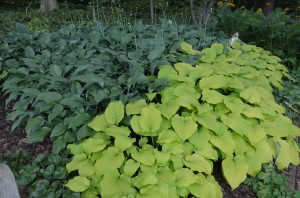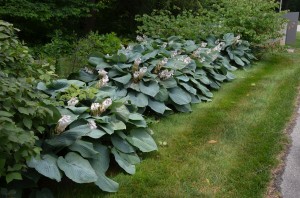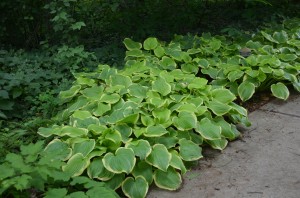During my annual summer travel to public gardens around the U.S., several clumps of old-timey hostas that were popular in the 1960’s and ’70’s caught my eye. These hosta beauties still own their garden place. Here are listed only four, but there are so many more.
‘Gold Standard’is an old-time favorite. In August multiple pink-lavender floral scapes up to 30 inches tall rise above a 22 inch wide plant mound. Flower fragrance is faint, never overwhelming. Summer foliage has a high gloss; yellow-gold leaf centers darken to a deep avocado shade circumvented by a medium green margin. Leaves average 8 inches in length and 6-8 inches in width. Leaf venation is average, not prominently displayed as on some cultivars.
‘Elegans’, a variety of Hosta sieboldiana, is an extra large hosta with powdery blue heart-shaped leaves. Early spring foliage is deeply textured with powdery wax coating. The white flowers peak through the July-August foliage. This large hosta measures up to 30 inches high and 48-60 inches in spread depending on its age and care.
‘Piedmont Gold’ is another large selection (20-25 inches high and 50-55 inches spread). It stands out with bright golden-yellow foliage with a dusty or powdery finish. The near-white flowers open in July. exhibits good slug resistance.
‘June’ is an medium-size hosta that sports beautiful golden yellow centered leaves streaked with a wide blue-green leaf rim. Pale lilac flowers appear in July. June has moderate slug resistant and is the most sun tolerant of the four.
Plant these cultivars in a full to moderately shady site and in moist well-drained soil. Feed hostas in early spring with a slow release fertilizer such as Osmocote™ or Nutricote™. Hostas are low care perennials ideal in shady, woodland settings, tubs and patio pots, or as a single specimen or in multiples for edging beds.
Hostas are commonly divided in either spring or fall, but these four may be left alone for years.




 Posted in
Posted in 
